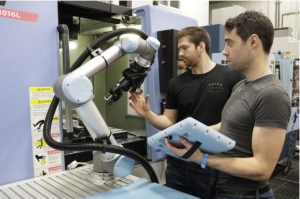
Robotiq Grippers For Collaborative Robots
Grippers for Collaborative Robots
When we say collaborative robots or “cobots,” we often refer to the robot arm. Of course, the robot arm is not able to pick parts, sense force, or detect objects on a work plane all by itself — it needs a helping “hand” to perform its tasks. We call these the end-of-arm tooling, with the most common one being the gripper. Grippers give the robot arm the ability to pick up parts to perform various tasks, including insertion and pick-and-place as well as machine tending. Grippers are as much part of the robot cell as the robot arm is. In collaborative applications, the gripper is responsible for handling parts in a safe and secure manner.
Many elements should be considered when integrating a collaborative robot cell that includes a gripper. When it comes to choosing a gripper, the number of options can be overwhelming. Several factors should be considered when making that decision. Once a gripper has been chosen, there are a few basic points that should be covered in order to integrate and program the collaborative gripping application.
Safety with Grippers and Cobots:
When choosing a gripper for a collaborative application, a range of elements must be considered. The gripper has to be assessed on its own in addition to as a part of the whole collaborative application.
First, you should avoid grippers with sharp edges and pinch points. If moving parts are accessible by operators, do they represent a hazard? Smooth edges are better than sharp ones, due to the reduced risk of injury.
The part’s temperature should also be considered when assessing the risks of the collaborative cell. If objects with high temperatures are picked up, the gripper should be able to withstand the heat without representing a risk of burning the operators.
Other potential hazards to consider are collisions with the work plane, the environment, fixtures, parts and workers. The robot arm should be set up and controlled in a manner that avoids and reduces the risk of those hazards. Consider not only the collision hazard of the gripper on the robot, but also of the part being picked up.
What to Consider when Choosing a Gripping Technology:
While keeping in mind the technical standards for collaborative robots, you need to define your needs for the gripper. The key to choosing a gripping technology for a robot cell is understanding the application. What task will the robot actually be doing? The gripper will of course have to pick up a part at some point, but then, what action will be taken?
● How will the gripper pick up the part?
● What will the gripper do with the part?
In addition, there are many technical specifications and other aspects that will influence the choice of gripper for a collaborative robot cell. To read more, download the eBook!
Click here to download the eBook






